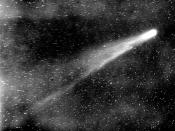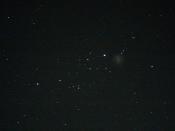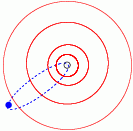Comets, or "shooting stars" are relatively small, icy celestial bodies that revolve around the sun. In the comets approach to the sun, some of the ice in the comet turns into gas, thus creating a long luminous tail that streams behind the comet. Over the past 2,500 years, approximately 2,000 comets have been observed and recorded. Several hundred comets were not visible to the naked eye, and were discovered during the past few decades with the aid of astronomical instruments. Large comets were often viewed as astronomic phenomena until 1577 when Danish astronomer Tycho Brache proved that they were celestial bodies. A comet consists of a small nucleus embedded in a nebulous disk called the coma. American astronomer Fred L. Whipple proposed in 1949 that the nucleus, containing practically all the mass of the comet, is a "dirty snowball" conglomerate of ices and dust. British astronomer Edmond Halley proved the comet of 1682 to be identical with the two that had appeared in 1607 and 1531, successfully predicting the comet's next return, which occurred in 1758.
What came to be known as "Halley's Comet" most recently passed around the sun again in 1986. The website www.planetscapes.com contains detailed information about the composition of comets, famous observers and interesting pictures that aid in the learning process. One extremely helpful tool that exists on the website is making the observers names into individual links in order to retrieve intriguing facts about their background. The site www.seds.1pi.arizona.edu contains very interesting facts about the sun and its composition. The sun is the most prominent feature in our solar system. containing approximately 98% of the total solar system mass, one hundred and nine earths would be required to fit across the sun's disk and the sun's interior could hold over 1.3 million earths. Solar...



More on comet definition
Comets are small, fragile, irregularly shaped bodies composed of a mixture of non-volatile grains and frozen gases. They have highly elliptical orbits that bring them very close to the Sun and swing them deeply into space, often beyond the orbit of Pluto.
Comet structures are diverse and very dynamic, but they all develop a surrounding cloud of diffuse material, called a coma, that usually grows in size and brightness as the comet approaches the Sun. Usually a small, bright nucleus (less than 10 km in diameter) is visible in the middle of the coma. The coma and the nucleus together constitute the head of the comet.
Source: http://www.solarviews.com/eng/comet.htm
0 out of 0 people found this comment useful.